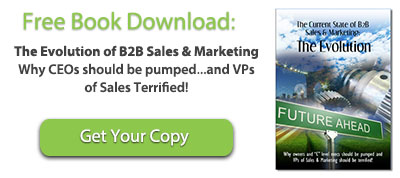This originally appeared as a guest post written for the Mass Manufacturing Extension Partnership monthly newsletter in September. The original article can be found here.
The Manufacturing Advancement Center, Next Generation Manufacturer blog provides "Insights, best practices, how to's, and success stories from manufacturing organizations in New England."
Business Expansion Strategy: Identifying, Acknowledging, & Overcoming the Fundamental Dissonance Between Top Line and Bottom Line, Part 1
Faster, cheaper, efficiency, & quality
 This is the mantra of manufacturers in America today. The science of operations and manufacturing created management tools that enable incredible outcomes. Today, advanced manufacturers in the U.S. can compete with any in the world; even basic manufacturing leads, as well. Certainly rising labor costs in other markets and a healthy dose of inexpensive natural gas based energy helps us, but the hard work of organizations like MassMEP has paid off. LEAN, workforce enablement, and similar initiatives, combined with American ingenuity and determination have vaulted US manufacturing from its nadir back to global leadership.
This is the mantra of manufacturers in America today. The science of operations and manufacturing created management tools that enable incredible outcomes. Today, advanced manufacturers in the U.S. can compete with any in the world; even basic manufacturing leads, as well. Certainly rising labor costs in other markets and a healthy dose of inexpensive natural gas based energy helps us, but the hard work of organizations like MassMEP has paid off. LEAN, workforce enablement, and similar initiatives, combined with American ingenuity and determination have vaulted US manufacturing from its nadir back to global leadership.
Managers now rely on weekly, daily, or even hourly dashboard reports to monitor critical KPIs for any deviation or hint of inefficiency. And when one is noted, well rehearsed procedures quickly identify and correct the root cause. Similarly, each cost account on the P&L is instinctively understood and assiduously monitored.
It works. Productivity is high and bottom lines are rock solid.
And then there's sales growth…
Compared to the actionable, real-time data in operational reporting, however, sales reports are typically a periodic regurgitation of stale and unpredictable pipeline. Whether simple excel sheets or polished HTML snapshots showing adjusted pipeline by rep, likelihood, product line and anticipated date of close, they are educated guesses at best and often "check the box" resubmissions.
Report content and format is a function of management preference, whether operational or sales. But the contrast between bottom and top line reporting highlights manufacturing's greatest risk & opportunity.
Bottom Line Rigor vs. Top Line Fluff
We're not picking on sales & marketing: there are a lot of intelligent, hardworking and dedicated folks working hard at business development for manufacturers. Of course, there were a lot of intelligent, hardworking, and dedicated folks working in manufacturing operations in the 80s too….
Over the last two decades the manufacturing and operations side of business has evolved. The human capital is now empowered with reengineered processes that create the structure and environment for success.
On the sales & marketing side, though, little has changed during those twenty years. The Sales & Marketing org chart is pretty similar to 1980. Generally there's a small marketing contingent responsible for product marketing (requirements, roadmap, pricing, sales support) and corporate marketing (trade shows, marcom, advertising, etc.) There is a larger direct sales force which sells (cold calling and lead follow up) directly and/or manages sales channel.
And technique hasn't changed much. Markets are defined, and product benefits (most speak less often of features now) are the basis for most marketing and sales collateral and presentations. The sales plan is built around a certain level of cold calls/leads translating sequentially to a predictable number of projects, and in turn sales from which revenue projections are extrapolated.
Of course there are new 'information age' tools to compliment traditional approaches:
- Companies typically have websites that tell a bit about themselves and list their products and capabilities - these ‘brochure sites' were originally to establish credibility
- Sales reps no longer carry pockets full of dimes for pay phones
- CRM (customer relationship management) software provides companies centralized GIGO databases of contacts and projects
- and email is now essentially a time consuming ‘end' rather than an enabling ‘means'
In short, while manufacturing has been reinvented, business development has largely remained the same.
Why the Dissonance?
It's simple. Most founders and executives of manufacturing companies are product folks. They look at the world in the context of things that are concrete & measurable. That pragmatic outlook dovetails comfortably with the measurement and management fundamental to advanced manufacturing. It conflicts, however, with the messy and unpredictable world of business development which turns on emotion, capricious preferences and unpredictable procurement cycles.
Simple to explain, though, doesn't mean easy to overcome. First, companies must decide "Does it matter?" Then, if they believe it does, they must apply process excellence to business development just as they did manufacturing. Finally, they must persevere through the challenges of implementation - just as a LEAN implementation involves some dark days, reengineering biz dev does too.
Does it Matter?
Is the effort really necessary?
Like the proverbial frogs in cold water gradually coming to boil, many companies intuitively understood that the manufacturing world was changing in the 80s but they only responded decisively in response to a crisis. Maybe it was an assignment to their lender's ‘workout group' or perhaps a catastrophic receivables loss or liquidity squeeze.
In contrast, aside from some tense months in 08-09, few companies have had a legitimate biz dev crisis recently. Rather there's the same sort of low grade background uncertainty similar to the early days of the manufacturing crisis.
Today most manufacturers report:
- compressed margins
- increased competition
- outrageous customer expectations
- unpredictable sell cycles
And just as most companies responded to the brewing manufacturing crisis with a triple check for QC (more of the same), most companies try sales training, another trade show, more cold calls or the like - in other words more of the same business development approaches that are increasingly ineffective. They may temporarily mitigate the symptoms, but they don't fix the problem.
The Business Development Problem
Is there a problem that needs to be fixed? Yes! But it's not a problem of tactics - it's fundamentally one of strategy.
And it's fundamentally one which can be solved with the same metrics informed and ROI driven application of process excellence to the top line - just as you have successfully done with the bottom line.
The second installment..."The Solution" which will outline the framework for an appropriate business expansion strategy for advanced manufacturers will follow next month. It's a subject that's important not only to manufacturers, but also to their trade associations.



